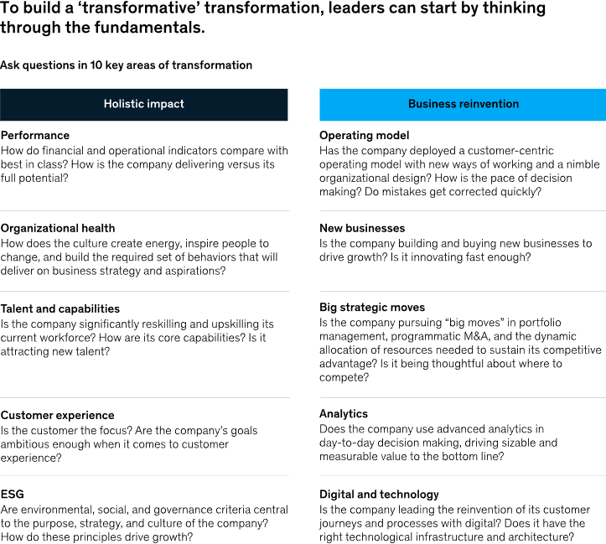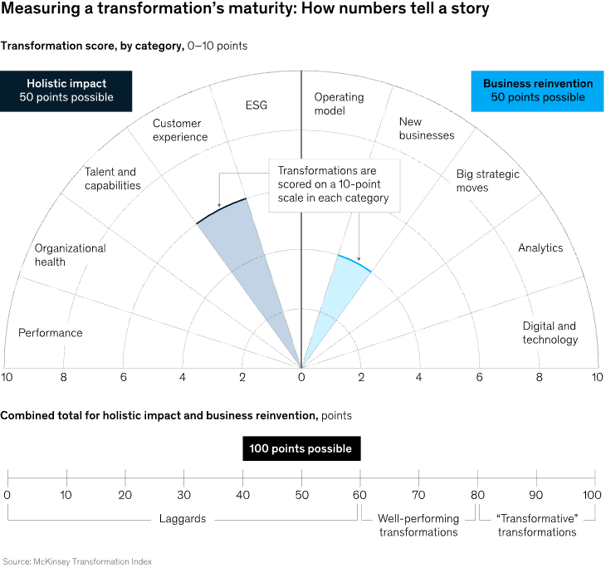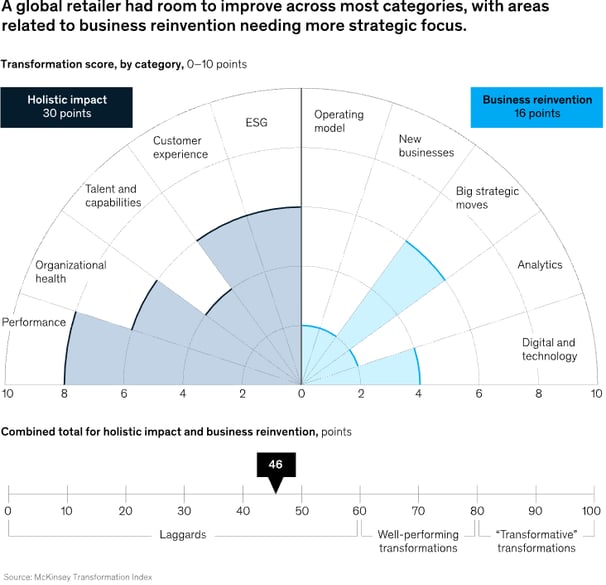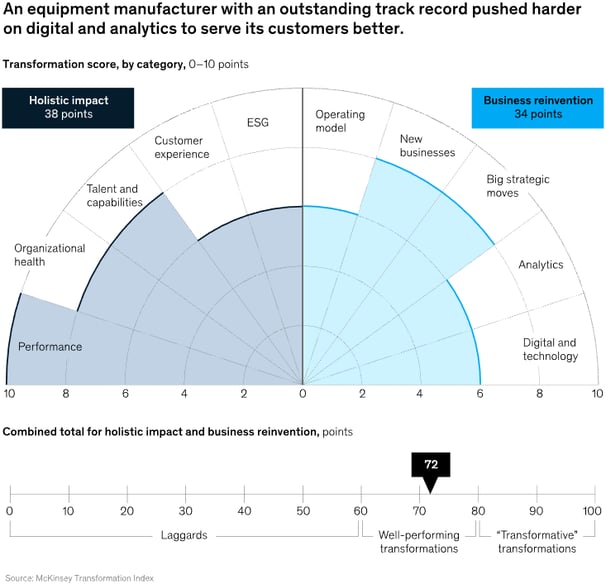
Business Transformation: A Novel Way to Measure Progress
Organizations that successfully pull off a high-performing transformation don’t choose between either holistic performance or business reinvention. They pursue both.
In an unpredictable and constantly evolving business environment, organizations of all shapes, sizes, and sectors are faced with a myriad of challenges. From digital newcomers eroding market share across industries to the rising popularity of ecosystem-centric strategies, and the increased appeal of corporations committed to environmental, social, and governance (ESG) principles to employees and investors—businesses have their work cut out for them.
Based on VVGS's investigations into corporate resilience, it has become increasingly clear that the answer to such uncertainty lies in leaders and businesses that are agile enough to seize opportunities for growth while simultaneously managing potential risks. Rather than simply focusing on financial performance, cost-cutting measures, or basic updates to the core business, leaders who truly want to succeed in this volatile climate are looking towards comprehensive organizational transformation—this involves improving customer experience, employee satisfaction, and making a positive societal impact.
Yet, historical data from VVGS highlights the harsh reality that successful transformations are elusive, with the majority failing to achieve their intended goals. However, among the successful transformations, a minute percentage not only deliver superior value rapidly, but also manage to sustain this profitable growth over a long term. These are the rare breeds of "transformative" transformations.
These observations raise a critical question for companies hoping to join this elite group—how does one initiate and execute such a transformative change? Recent dialogues with numerous CEOs and C-suite leaders indicate that while many understand the need for transformation, they are often unsure about the starting point or whether their current efforts would yield the desired value.
This article aims to dissect the distinctive traits shared by successful transformative efforts and the potential value that organizations stand to gain from embarking on this path. A novel method of evaluating transformation progress is also introduced, involving a series of focused questions across ten categories pertaining to holistic performance and business reinvention. This method can provide leaders with a precise evaluation of where their transformation efforts are currently succeeding and areas requiring further effort.
Characteristics of Successful Transformations
Even among transformations that reach their intended targets, there are vast disparities in performance and outcomes. Successful transformations often have five common traits:
Thinking Big: They set ambitious goals, delivering 2.7 times the initially estimated value.
Multilevel Action: More than 50% of the transformation’s value is generated from top-line initiatives.
Rapid Movement and Renewal: Nearly 75% of the value is implemented during the first year.
Holistic Focus: Roughly 55% of the transformation’s value comes from small initiatives representing less than 0.5% of full potential.
Culture of Change: They foster a culture that leads to superior total shareholder returns (three times higher than the peer average).
However, transformative transformations go a step further by incorporating three additional strategies:
Reinvention of the core business, leveraging digital and analytics.
Development or acquisition of new businesses to generate new sources of revenue.
Revamping of the operating model to focus on speed and innovation.
Though these transformative efforts represent just 5% of all transformations, they deliver 4.5 times the value. At the strategic level, these transformations achieve a well-managed equilibrium between enhancing holistic performance and reinventing the business—exceling in both.
Holistic performance spans five dimensions reflecting organizational priorities: financial performance, organizational health, talent and capabilities, customer focus, and ESG impact. Business reinvention, on the other hand, involves pursuing an ambitious shift in a company’s core operating model, portfolio, strategic moves, and digital and analytics capabilities.
Top performers grasp that a company can focus on enhancing holistic performance (e.g., doubling the bottom line), but it also needs to build its reinvention capability to respond effectively in uncertain times. Conversely, an organization can prioritize reinvention, but if it does not deliver financial results, the transformation is unlikely to be sustainable.
Following the commitment to a transformation, the executive team should probe ten categories about the holistic performance and business reinvention it targets, to help sharpen goals and execute them swiftly (Exhibit 1).
Transformation Tool for the C-Suite
CEOs and other C-suite leaders often grapple with big issues but lack clarity on the most productive path forward. Questions range from resource allocation between new and existing businesses, choosing between a "big bang" scale-up or a sequenced transformation, transcending mere management of ESG risks to creating value from ESG criteria, and implementing large-scale organizational change sustainably.
To address these concerns, the "Transformation Speedometer" was developed—a tool that analyzes a company’s transformation maturity based on its specific contexts and needs through a score called the McKinsey Transformation Index. Achieving excellence in every area of business reinvention and holistic performance is rare; even the healthiest organizations have gaps. Despite leaders having deep insights into their businesses, this analysis can reveal unanticipated improvement opportunities.
Different Companies, Different Paths
In this method, leaders rate each of the ten categories on a scale from zero to ten. On a 100-point scale, companies lagging in their transformation progress rank below a 60; companies with solid-performing transformations rank from 60 to 80; and transformative transformations score above 80 (Exhibit 2).
A balanced score above 80 across all dimensions is rare. More commonly, high performers excel significantly in a few dimensions, while there's ample room for improvement in others. Depending on the context of the organization and sector, these scores can spark intense discussions among leaders about improvement strategies.
For instance, a global retailer with strong financial performance but lackluster reinvention skills decided to remodel processes, systems, and talent management, with a particular emphasis on investing in analytics, digital capabilities, and talent (Exhibit 3).
On the other hand, an incumbent equipment manufacturer with exceptional holistic performance sought to strengthen its business reinvention dimensions by modernizing through analytics to quickly identify customer needs and respond to new trends (Exhibit 4).
From Scores to Action
This assessment can reveal important insights. First, it is nearly impossible to excel in all ten categories. Small improvements across all dimensions do not yield the best results—bold and swift actions in a few will. Second, the assessment can aid CEOs and management teams in making decisions, setting priorities, and identifying potential blind spots. Third, these discussions are crucial for agreeing on how to allocate resources and define objective targets for impact measurement and progress assessment. Finally, establishing ambitious goals and a shared vision helps maintain a high level of commitment to the work that needs doing.
Resilient businesses view moments of crisis or uncertainty as opportunities to transform themselves, thereby generating more value in both growth and recovery cycles. As Ayrton Senna, the Brazilian car racing champion, once noted, "You cannot overtake 15 cars in sunny weather, but you can when it's raining." By equally focusing on holistic performance and business reinvention, companies greatly improve the odds of their transformations creating sustainable and disproportionate value. This balanced approach ensures that an organization thrives in the future, regardless of whether it's raining or shining.








Talk to Us

